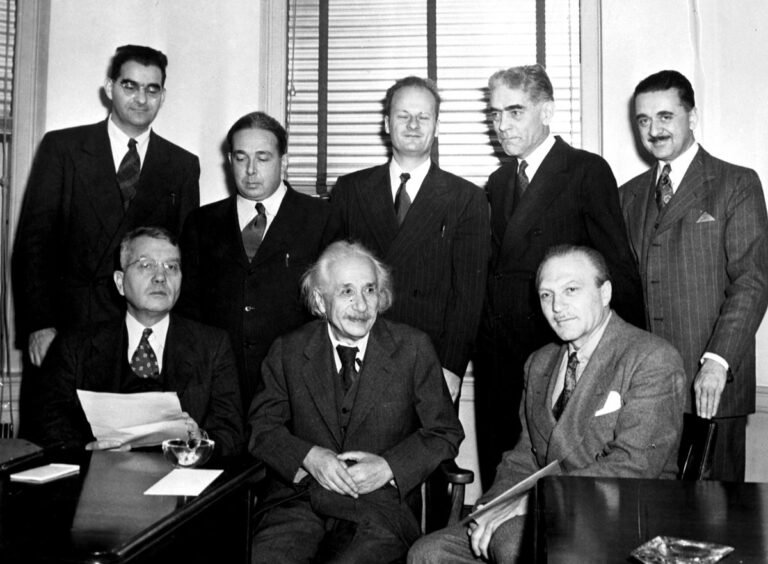U.S. Science—and Scientific American—Have Weathered Attacks Before and Won
Federal officials seized 3,000 copies of Scientific American in 1950 in a “red scare” era of attacks on science. The move backfired, and offers lessons for today
Albert Einstein and other scientists, including Hans Bethe standing behind him, in 1946.
Smith Archive/Alamy Stock Photo
Worth recalling in this anniversary year, one of Scientific American’s proudest moments came in a past era of attacks on science. The lesson—that speaking out for science is worth the criticism it brings—is surely worth recalling today.
The year was 1950, and the “red scare” was fully underway, alongside a nascent arms race between the U.S. and the Soviet Union. The Soviet demonstration of an atomic bomb in 1949 had galvanized calls for a bigger bomb, a hydrogen bomb, in the U.S., sparking the paranoia today best remembered for claiming the career of Manhattan Project chief J. Robert Oppenheimer. But a war on scientists not toeing the political line was in full swing then, and Scientific American was in the thick of it.
On March 20, 1950, a U.S. Atomic Energy Commission agent named Alvin F. Ryan seized and burned 3,000 copies of the forthcoming April issue of Scientific American, which the commission claimed held atomic secrets. Ryan also supervised the melting of four printing plates holding a feature story in the issue, “The Hydrogen Bomb: II,” that contained the supposedly objectionable information within one of its columns.
On supporting science journalism
If you’re enjoying this article, consider supporting our award-winning journalism by subscribing. By purchasing a subscription you are helping to ensure the future of impactful stories about the discoveries and ideas shaping our world today.
“Strict compliance with the commission’s policies would mean that we could not teach physics,” said an outraged Gerard Piel, then publisher of Scientific American, in the April 1, 1950, report of the seizure on the front page of the New York Times. He threatened to take further censorship to the Supreme Court.
Piel had relaunched Scientific American in 1948, with a focus on bringing the views of scientists like Bethe, thoughtfully edited, to the public. This scientists-as-writers approach came about by happenstance, Scientific American editor Gary Stix found while researching the history of the magazine. Piel found it was cheaper to pay scientists to write copy and then rewrite it, rather than hire magazine writers. The approach proved so successful, with the public then clamoring to hear the news straight from scientists, that the magazine had 100,000 readers and 133 pages of advertising by 1950.
Berthe’s article was just one of four published by the magazine on the H-bomb, which President Harry Truman had decided to pursue in January of 1950. Much debate, among scientists and the public, followed over whether such a weapon would make the U.S. safer or endanger humanity. The Nobel Prize–winning discoverer of how fusion in stars baked elements, Bethe, was in the latter camp. His article went through the physics of fusion and pled to “save humanity from this ultimate disaster” by reconsidering the president’s H-bomb decision, or at least pledging no first use of the weapons in warfare, a commitment still unmade, and widely debated in nuclear circles.
“Piel had made his publication an important forum for critical analysis of U.S. science policy during the coldest years of the cold war,” in exposing the Atomic Energy Commission’s attack on press freedom, wrote history professor Alfred W. McCoy. To satisfy the AEC, Bethe made four “ritual” cuts to the final version of the article and published it.
Even so, U.S. security officials continued to pressure scientists and the press over the course of the red scare. The FBI searched Bethe’s luggage after a European trip in 1951. “Scientific American runs to the sort of stuff which the Soviets would like to see in a popular science journal,” claimed an AEC memorandum that same year. The U.S. tested its first H-bomb a year later, and stripped Oppenheimer of his security clearance, in 1954, in a power play now seen as a political vendetta. The arms race played out through the 1960s, building stockpiles of tens of thousands of nuclear missiles on both sides until its folly, and frightening close brushes with Armageddon, lowered those numbers in an era of détente, the sort of world that Bethe had called for in his article.
All the while, Scientific American stood for the importance of scientists speaking out, and providing the public, even amid the unhinged persecution of the red scare, choices for a better world. Throughout science, the lesson stood, among eminent voices ranging from Linus Pauling to Carl Sagan. Scientists led calls for test ban treaties and disarmament; they warned of nuclear winter throughout the cold war. In the magazine, former CIA official Herbert Scoville Jr. warned of the danger of a new generation of U.S. submarines as “first-strike” weapons, that familiar warning, in 1972. Bethe himself kept speaking out, against the Reagan administration’s “Star Wars” missile defense plan as unworkable, costly and destabilizing in the 1980s (views heard today on its current “Golden Dome” revival). Accepting the Einstein Peace Prize in 1992, he acknowledged that while scientists had not ended the cold war, they had succeeded in “planting the idea there was an alternative to the arms race.”
Their example, and that idea, remains as important as ever, especially with U.S. science facing severe cuts, and nuclear weapons a renewed flashpoint in geopolitics. Piel’s statement released after the 1950 seizure—“there is a very large body of technical information in the public domain which is essential to adequate public participation in the development of national policy and on which the American people are entitled to be informed”—still stands true today at this magazine. We will continue to speak out and provide scientists with a place to make their voices heard.
This is an opinion and analysis article, and the views expressed by the author or authors are not necessarily those of Scientific American.
